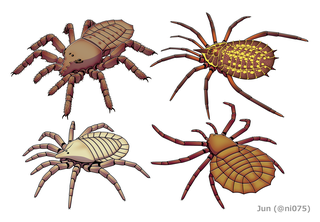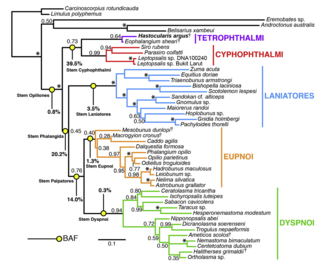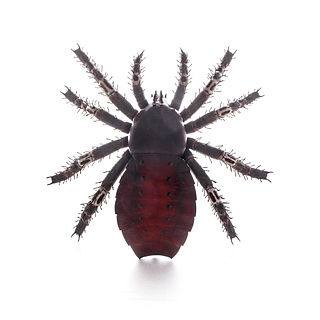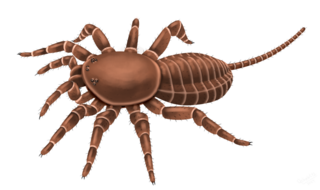
The subphylum Chelicerata constitutes one of the major subdivisions of the phylum Arthropoda. Chelicerates include the sea spiders, horseshoe crabs, and arachnids, as well as a number of extinct lineages, such as the eurypterids and chasmataspidids.

Ricinulei is a small order of arachnids. Like most arachnids, they are predatory, eating small arthropods. They occur today in west-central Africa (Ricinoides) and the Americas as far north as Texas. As of 2021, 91 extant species of ricinuleids have been described worldwide, all in the single family Ricinoididae. In older works they are sometimes referred to as Podogona. Due to their obscurity they do not have a proper common name, though in academic literature they are occasionally referred to as hooded tickspiders.

Montceau-les-Mines is a commune in the Saône-et-Loire department in the region of Bourgogne-Franche-Comté in eastern France.

Arthropleura is a genus of massive millipedes that lived in what is now North America and Europe around 345 to 290 million years ago, from the Viséan stage of the lower Carboniferous Period to the Sakmarian stage of the lower Permian Period. The species of the genus are the largest known land invertebrates of all time, and would have had few, if any, predators.

Plesiosiro is an extinct arachnid genus known exclusively from nine specimens from the Upper Carboniferous of Coseley, Staffordshire, United Kingdom. The genus is monotypic, represented only by the species Plesiosiro madeleyi described by Reginald Innes Pocock in his important 1911 monograph on British Carboniferous arachnids. It is the only known member of the order Haptopoda.

The order Trigonotarbida is a group of extinct arachnids whose fossil record extends from the late Silurian to the early Permian. These animals are known from several localities in Europe and North America, as well as a single record from Argentina. Trigonotarbids can be envisaged as spider-like arachnids, but without silk-producing spinnerets. They ranged in size from a few millimetres to a few centimetres in body length and had segmented abdomens (opisthosoma), with the dorsal exoskeleton (tergites) across the backs of the animals' abdomens, which were characteristically divided into three or five separate plates. Probably living as predators on other arthropods, some later trigonotarbid species were quite heavily armoured and protected themselves with spines and tubercles. About seventy species are currently known, with most fossils originating from the Carboniferous coal measures.

Phalangiotarbida is an extinct arachnid order first recorded from the Early Devonian of Germany and most widespread in the Upper Carboniferous coal measures of Europe and North America. The last species are known from the early Permian Rotliegend of Germany.

Tetrapulmonata is a non-ranked supra-ordinal clade of arachnids. It is composed of the extant orders Uropygi, Schizomida, Amblypygi and Araneae (spiders). It is the only supra-ordinal group of arachnids that is strongly supported in molecular phylogenetic studies. Two extinct orders are also placed in this clade, Haptopoda and Uraraneida. In 2016, a newly described fossil arachnid, Idmonarachne, was also included in the Tetrapulmonata; as of March 2016 it has not been assigned to an order.

Spiders have been evolving for at least 380 million years. The group's origins lie within an arachnid sub-group defined by the presence of book lungs ; the arachnids as a whole evolved from aquatic chelicerate ancestors. More than 45,000 extant species have been described, organised taxonomically in 3,958 genera and 114 families. There may be more than 120,000 species. Fossil diversity rates make up a larger proportion than extant diversity would suggest with 1,593 arachnid species described out of 1,952 recognized chelicerates. Both extant and fossil species are described annually by researchers in the field. Major developments in spider evolution include the development of spinnerets and silk secretion.

Anthracomartidae, first described by Haase, 1890, is a family of the extinct arachnid order Trigonotarbida. It is likely to be most closely related to the Archaeomartidae, based on a 2014 cladistic analysis, within the clade.

Harvestmen (Opiliones) are an order of arachnids often confused with spiders, though the two orders are not closely related. Research on harvestman phylogeny is in a state of flux. While some families are clearly monophyletic, that is share a common ancestor, others are not, and the relationships between families are often not well understood.

Eophrynus is an extinct genus of arachnids from the extinct order Trigonotarbida, which lived during the Late Carboniferous period in Europe. The genus was first described in 1871 by Henry Woodward (geologist). The name comes from Eo, meaning 'dawn', and Phrynus, an extant genus of whip spider.

Anthracomartus is an extinct genus of Carboniferous-aged trigonotarbid arachnids. A fossil of the species Anthracomartus hindi was found to be 23 millimetres (0.91 in) long and 14 millimetres (0.55 in) wide.

Eophrynidae is a family of the extinct arachnid order Trigonotarbida. Eophrynids lived during the Carboniferous period in what is now modern Europe and North America. The family is probably found within the "eophrynid assemblage" clade:.

Tetrophthalmi is an extinct suborder of Opiliones that had both median and lateral eyes. First described in 2014, it is known from two extinct species. Phylogenetic analysis suggests that this eye arrangement is the ancestral condition for harvestmen, placing Tetrophthalmi and Cyphophthalmi in a basal position within Opiliones.

Palaeocharinus is a genus of extinct trigonotarbid arachnids known from the Devonian of western Europe. The genus was first found and described in the Rhynie chert in the 1920s by Arthur Stanley Hirst and S. Maulik. The family to which the genus belongs may be paraphyletic.

Uraraneida is an extinct order of Paleozoic arachnids related to modern spiders. Two genera of fossils have been definitively placed in this order: Attercopus from the Devonian of United States and Permarachne from the Permian of Russia. Like spiders, they are known to have produced silk, but lack the characteristic spinnerets of modern spiders, and retain elongate telsons.

Idmonarachne is an extinct genus of arachnids, containing one species, Idmonarachne brasieri. It is related to uraraneids and spiders.

Kreischeria is a genus of extinct trigonotarbid arachnids known from the Carboniferous of Germany.

Douglassarachne is an extinct genus of arachnid from the Late Carboniferous (Moscovian), known from single species D. acanthopoda. It is known exclusively from one specimen recovered from the Mazon Creek Lagerstätte, Illinois, US.




















